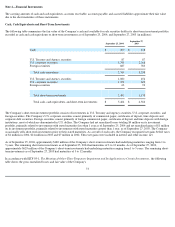Apple 2004 Annual Report Download - page 70
Download and view the complete annual report
Please find page 70 of the 2004 Apple annual report below. You can navigate through the pages in the report by either clicking on the pages listed below, or by using the keyword search tool below to find specific information within the annual report.
translation adjustment. Any residual changes in fair value of the forward contract, including changes in fair value based on the differential
between the spot and forward exchange rates, are recognized in current earnings in other income and expense.
Inventories
Inventories are stated at the lower of cost (first-in, first-out) or market. If the cost of the inventories exceeds their market value, provisions are
made currently for the difference between the cost and the market value.
Property, Plant, and Equipment
Property, plant, and equipment are stated at cost. Depreciation is computed by use of the straight-line method over the estimated useful lives of
the assets, which are 30 years for buildings, from 2 to 5 years for equipment, and the shorter of lease terms or 10 years for leasehold
improvements. The Company capitalizes eligible costs to acquire or develop internal-
use software that are incurred subsequent to the preliminary
project stage. Capitalized costs related to internal-use software are amortized using the straight-
line method over the estimated useful lives of the
assets, which range from 3 to 5 years.
Asset Retirement Obligations
On September 29, 2002, the Company adopted SFAS No. 143, Accounting for Asset Retirement Obligations , which addresses financial
accounting and reporting for obligations associated with the retirement of tangible long-lived assets and the associated asset retirement costs.
The standard applies to legal obligations associated with the retirement of long-lived assets that result from the acquisition, construction,
development and/or normal use of the assets. SFAS No. 143 requires that the fair value of a liability for an asset retirement obligation be
recognized in the period in which it is incurred if a reasonable estimate of fair value can be made. The fair value of the liability is added to the
carrying amount of the associated asset and this additional carrying amount is depreciated over the life of the asset. All of the Company's
existing asset retirement obligations are associated with commitments to return property subject to operating leases to original condition upon
lease termination. The Company estimated that as of September 29, 2002, gross expected future cash flows of $9.5 million would be required to
fulfill these obligations.
As of the date of adoption, the Company recorded a $6 million long-term asset retirement liability and a corresponding increase in leasehold
improvements. This amount represents the present value of expected future cash flows associated with returning certain of the Company's leased
properties to original condition. The difference between the gross expected future cash flow of $9.5 million and its present value of $6 million at
September 29, 2002, is being accreted over the life of the related leases as an operating expense. Net of the related income tax effect of
approximately $1 million, adoption of SFAS No. 143 resulted in an unfavorable cumulative-effect type adjustment to net income during the first
quarter of 2003 of approximately $2 million. This adjustment represents cumulative depreciation and accretion that would have been recognized
through the date of adoption of SFAS No. 143 had the statement been applied to the Company's existing asset retirement obligations at the time
they were initially incurred.
66
























